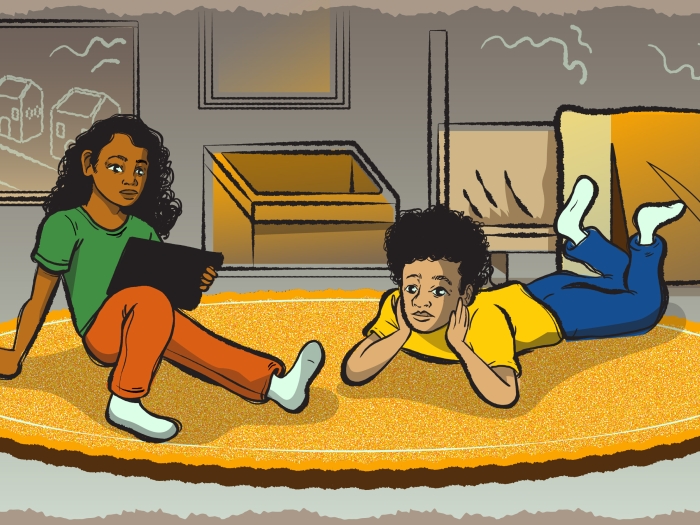New program hopes to reduce risk for psychiatric emergency patients and their families.
1:50 PM
Author |

A new effort to reduce the risk of firearm injury by offering free gun locks and educational resources to people receiving care for a mental health crisis is now under way at Michigan Medicine.
Initially, the effort focuses on patients at the University of Michigan Health psychiatric emergency department, and their accompanying loved ones, who can now take home free gun locks to safeguard firearms in their homes, and educational materials about safe storage.
Research has shown that the risk of suicide or other harm is higher when firearms are not stored in a secure fashion, no matter whether someone has a mental health condition or not. About half of all suicide deaths in the United States involve firearms, and 90% of suicide attempts involving a firearm are fatal.
Screening and free gun locks for those in mental health crisis
The U-M care team recently enhanced efforts to ask all psychiatric emergency patients, or their parents or guardians of patients under age 18, about the presence of firearms in their homes and how those firearms and ammunition are stored.
Even if a patient or family doesn't need a gun lock or declines the offer, psychiatric emergency staff are providing information about the benefits of safe storage practices.
The initiative is supported in part by the federal Substance Abuse and Mental Health Services Administration through a grant based at the Michigan Department of Health and Human Services, called Transforming Youth Suicide Prevention in Michigan-3. The goal is to create a model that other emergency providers can use.
"We have asked about firearms in the home as part of our routine intake questions for years, but this expanded screening, education and gun lock program takes our preventive effort to the next level," said John Kettley, L.M.S.W., the chief social worker for psychiatric emergency services in the Department of Psychiatry. "We hope that other mental health, emergency and primary care providers will consider adding detailed screening and education for their patients, no matter what their diagnosis."
He notes that gun locks are also available for free to the community at many law enforcement agencies and at low cost at many retailers.
Taking prevention to the next level
Victor Hong, M.D., medical director of psychiatry emergency services, notes that psychiatric emergency providers increasingly see the importance of using the crisis that brings a child, teen or adult into their care as a "teachable moment."
"If someone has chosen to have firearms in their home, and does not secure them, they need to understand what that means for the risk of suicide, and intentional or unintentional harm, for everyone who lives there or visits," he said. "A locked gun, with the key and ammunition stored separately, can make a difference in the heat of a crisis."
The entire staff of psychiatric emergency services has also received specialized training called Counseling on Access to Lethal Means. It is available for free to anyone involved in patient care or outreach, to help them identify and counsel at-risk people.
Disseminating best-practice suicide prevention strategies within emergency departments across Michigan is one component of Michigan's youth suicide prevention SAMHSA grant.
We hope that other mental health, emergency and primary care providers will consider adding detailed screening and education for their patients, no matter what their diagnosis.John Kettley, L.M.S.W.
Cynthia Ewell Foster, Ph.D., leads the Suicide Prevention Emergency Department Technical Assistance Center, which includes Kettley, Hong, and other members of U-M's Department of Psychiatry.
"It's wonderful to see the generosity of our team at Michigan Medicine sharing their expertise with other emergency departments across the state while also using this opportunity to improve our own care at U-M," said Ewell Foster, a clinical associate professor of psychiatry.
SEE ALSO: The Power of Caring: Forming a Circle of Support Around Suicidal Teens
The team worked with Michigan Medicine's information technology experts to create a new screening tool within the electronic health record, to make it part of the intake process when a patient arrives for psychiatric emergency care.
The wording of the screening tool was informed by firearm and suicide researchers who belong to the Firearm Safety Among Children & Teens Consortium, FACTS for short, a national federally funded research effort based at U-M.
This means the firearm screening tool could also be used in other care areas, or duplicated at other health systems that use the same electronic health record system as U-M.
The team has also created a publicly available brochure about specific steps to reduce suicide risk at home by removing or locking up potentially lethal means. It's adapted from one created by the Oakland Community Health Network.
Another resource developed as part of this effort is a flyer that includes information on other safe storage options for firearms, which is available on the website of the U-M Injury Prevention Center.
Plans for more safe storage
The psychiatric emergency team is working to launch an additional program to allow patients or patient families to voluntarily have their firearms stored out of their homes in the vaults at law enforcement agencies.
Once that program is launched, they hope to share the procedures with other mental health providers and law enforcement agencies so that they can model their own safe-storage programs after it.
"Creating partnerships among law enforcement, mental health agencies and providers who work together toward a common goal of reduced harm from intentional and unintentional firearm discharge is a huge benefit to the overall health of our community," said Brian Uridge, U-M deputy director of public safety and director of security for Michigan Medicine.
U-M recently launched a Firearm Injury Prevention Institute to generate new knowledge and advance innovative solutions to reduce firearm injury across the country. Ewell Foster and several FACTS members are members of the institute.
Suicide-safe household tips
-
Firearms: Remove firearms from the household if someone in the household has expressed suicidal thoughts or attempted suicide or has a mental health concern. Ask a trusted friend or family member to keep them temporarily. If firearms can't be removed from the home, securely lock them and their ammunition separately.
-
Medications: Follow the M E D S method: Monitor: Keep track of how many pills are in each prescription bottle or pack and don't keep lethal doses at home. Educate: Educate yourself and family members on the dangers of abusing prescription drugs. Dispose: Dispose of medicines safely to prevent medication abuse and environmental pollution. Secure: Keep medications, both prescription and over-the-counter, in a safe and secure location, such as a locked cabinet or private bathroom.
-
Other substances: Talk to children and teens about alcohol and drug use as a major risk factor for suicide. Lock up potentially harmful common household products and poisons.
-
Provide Support: Know the suicide warning sign. Create a safe, judgment free environment when talking about tough issues. If you notice significant changes, ask them directly if they're thinking about suicide. Asking does not increase the chance of a suicide attempt. Don't be afraid to seek help when needed.
When and how to get help
Call 911 if:
-
A suicide attempt has been made.
-
A weapon is present during a suicide crisis.
-
The person is out of control or if your safety is threatened.
Take immediate action and call a local crisis line or psychiatric emergency line if someone:
-
Makes a serious threat to kill themselves.
-
Looks for a way to carry out a suicide plan.
-
Talks about death or suicide in text messages, social media posts, etc.
-
Gives away their possessions.
-
Exhibits uncharacteristic behavior such as: Depression/hopelessness; Withdrawal from family or friends; rage, anger or seeking revenge; Anxiety agitation or sleep irregularity; Reckless or risky behavior; Dramatic mood changes; Excess alcohol or drug use; Expressions of no reason for living or no sense of purpose.
If you or someone you know is having a mental health crisis:
-
Michigan Medicine's Department of Psychiatry runs a mental health crisis phone service: 734-936-5900 or 734-996-4747 that is available 24 hours a day, 7 days a week. Read a list of local mental health crisis lines for each Michigan county.
-
The National Suicide Prevention Lifeline is 1-800-273-TALK (8255) or text "HOME" to 741741 or use the chat feature or TTY and Spanish-language options found on their website.
Grant information: Transforming Youth Suicide Prevention in Michigan, 5H79SM082148-02.

Explore a variety of health care news & stories by visiting the Health Lab home page for more articles.

Department of Communication at Michigan Medicine
Want top health & research news weekly? Sign up for Health Lab’s newsletters today!





